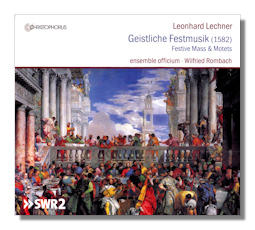
The Internet's Premier Classical Music Source
Related Links
- Lassus Reviews
- Latest Reviews
- More Reviews
-
By Composer
-
Collections
DVD & Blu-ray
Books
Concert Reviews
Articles/Interviews
Software
Audio
Search Amazon
Recommended Links
Site News
 CD Review
CD Review
Leonard Lechner

Geistliche Festmusick (1582)
- Leonard Lechner:
- Missa super Domine, Dominus noster
- Quid Chaos (à 24 Voci)
- Memor Esti Verbi Tui (à 6 Voci)
- O Fons Vitae - Sitio Domine (à 6 Voci)
- In Convertendo (à 6 Voci)
- Paratum Cor Meum (à 6 Voci)
- Kronberg Motets:
- In Laudem Regii Fontis
- In Connexum Regiarum Literarum
- In Symbola Regis Et Reginae
- Laudate Dominum à 15 Voci
- Orlando Lassus: Domine, Dominus noster
- Andrea Gabrieli: Praeludium secundum tonus
Ensemble Officium
Ensemble Gabinetto Armonico/Wilfried Rombach
Christophorus CHR77367
Leonard Lechner (1553-1606) was particularly well-placed to observe and absorb major trends in late Renaissance musical culture. He was born (probably) in the South Tyrol and worked – at first as a pupil of Lassus – in Munich. This was sufficiently close to Northern Italian (especially Venetian) musical life for Lechner to be familiar at first hand with advances in compositional and performance style. Bavaria was a lively musical environment in many ways – not least in that it apparently encouraged its (court) musicians to travel; as indeed Lechner did – to Italy, where (despite his conversion to Protestantism) the composer clearly fell under an emotional as well as a technical spell of the transparency and brilliance of contemporary and recent Italian music.
This CD from Christophorus by the 30-person Ensemble Officium (not all members of which sing in any one work) and the 8-strong Ensemble Gabinetto Armonico under Wilfried Rombach is a collection of 15 (accompanied and unaccompanied) vocal and one purely instrumental (Andrea Gabrieli's Praeludium secundum tonus [tr.2]) works performed in 1582 at the marriage in Nuremberg (where Lechner was archimusicus of local patricians, Sebald Welser and Magdalena Imhoff. It was an event of great public prominence; and obviously one for which festivity and lavish celebration were thought appropriate. So Lechner's music is outward-looking, optimistic, uplifting, affirmative and full of Italian light. Indeed, the longest single work on the CD, Quid Chaos [tr.8] is in places redolent of the soaring and all-embracing compass of Palestrina.
The Mass, Super Domine, Dominus noster is preceded here by Lassus' six-part motet of that name. It's equally splendid; the impact of the polyphonic sound predominates. Indeed, the aforementioned Quid Chaos was composed for three choirs of eight voices. As they do with all the music here, Ensemble Officium performs this with a perfect balance of authority and jubilation, though one might detect a little uncertainty in some of the very high notes; why was there no retake?
At the same time, pieces like the O Fons Vitae [tr.10] and In Convertendo [tr.11] show that the music is by no means spectacle for its own sake. But is music of real substance; nor is it related just to the marriage. The melodic lines are sensitive. They never display either a tilting forward at all costs, or a reticence to produce effect if that's what's needed. Similarly, Paratum Cor Meum [tr.12] is thoughtful and employs the same restraint. It's almost understated in the ways in which the music supports the text. For all Lechner's attraction to splendid sound, the text is clear. And very clearly and unostentatiously articulated here by Ensemble Officium.
In fact, it's transparency, clarity, cleanliness that characterize the performances on this CD. Dynamics are appropriate to the occasion, tempi are never excessive, never ponderous, never rushed. The textures which emerge as a result are pleasing and varied. A key purpose of the CD is to help listeners appreciate the kind of experience which those attending the marriage might have had. Yet this is beautiful, accomplished and compelling music in its own right. The performances reflect its essences more than they necessarily comment on the occasion for which it was composed.
In short, these are expert performances sung for the music's sake; not that of any compiled "effect", as could so easily have been the case. They are supported by the pure yet responsive acoustic of two different churches – actually miles apart. Director Wilfried Rombach clearly has great sympathy for the idiom and its particular evolution (that of music by a composer who made a virtue out of awareness of new influences). The results are this appealing CD which makes a specific and welcome addition to the repertoire.
The booklet that comes permanently attached to this well-produced Digipak is clear and easy to read, contains the original texts (and translations into German only), background to the music; but nothing about the musicians, alas. If Lechner, Lassus and Andrea Gabrieli delight you as much as they should, this is an attractive CD to investigate. None of the works here appears to be otherwise available in the current catalog; and the performances are very persuasive ones. Recommended.
Copyright © 2013, Mark Sealey





















